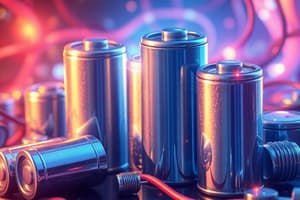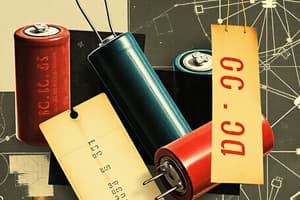Podcast
Questions and Answers
What is the primary purpose of a capacitor?
What is the primary purpose of a capacitor?
- To increase the resistance in a circuit
- To convert voltage into current
- To store energy in an electrostatic field (correct)
- To provide a direct current to the load
Which of the following equations describes capacitance?
Which of the following equations describes capacitance?
- C = Q - Vab
- C = Q + Vab
- C = Vab/Q
- C = Q/Vab (correct)
What happens to capacitance if the area of the capacitor plates is increased?
What happens to capacitance if the area of the capacitor plates is increased?
- Capacitance stays the same
- Capacitance becomes zero
- Capacitance decreases
- Capacitance increases (correct)
What is the consequence of increasing the distance between the plates of a capacitor?
What is the consequence of increasing the distance between the plates of a capacitor?
Which of the following correctly defines the unit of capacitance?
Which of the following correctly defines the unit of capacitance?
What characteristic of a dielectric affects the capacitance?
What characteristic of a dielectric affects the capacitance?
In a parallel-plate capacitor, how is capacitance mathematically expressed?
In a parallel-plate capacitor, how is capacitance mathematically expressed?
If a capacitor holds a charge of 5 coulombs and has a voltage of 2 volts, what is its capacitance?
If a capacitor holds a charge of 5 coulombs and has a voltage of 2 volts, what is its capacitance?
What effect does a dielectric have on the capacitance of a capacitor?
What effect does a dielectric have on the capacitance of a capacitor?
What is the relationship between voltage and the electric field in a capacitor?
What is the relationship between voltage and the electric field in a capacitor?
If the charge stored in a capacitor is doubled, what happens to the energy stored in the capacitor?
If the charge stored in a capacitor is doubled, what happens to the energy stored in the capacitor?
When a dielectric material is introduced to a capacitor, what is its effect on the electric field between the plates?
When a dielectric material is introduced to a capacitor, what is its effect on the electric field between the plates?
Given a defibrillator capacitor storing 73 J of energy and having a capacitance of 120 µF, what is the voltage across the capacitor?
Given a defibrillator capacitor storing 73 J of energy and having a capacitance of 120 µF, what is the voltage across the capacitor?
Which of the following describes the dielectric constant (K) of a material?
Which of the following describes the dielectric constant (K) of a material?
For a parallel-plate capacitor with a capacitance of 7.0 µF and plate area of 1.5 m², how does the area relate to capacitance with dielectric present?
For a parallel-plate capacitor with a capacitance of 7.0 µF and plate area of 1.5 m², how does the area relate to capacitance with dielectric present?
What happens to the potential difference in a capacitor when the charge is fixed and the dielectric material is introduced?
What happens to the potential difference in a capacitor when the charge is fixed and the dielectric material is introduced?
Flashcards
What is a capacitor?
What is a capacitor?
A passive electronic component that stores electrical energy in an electrostatic field.
What is the basic structure of a capacitor?
What is the basic structure of a capacitor?
It consists of two conductive plates separated by an insulating material called a dielectric.
How does capacitance relate to charge and voltage?
How does capacitance relate to charge and voltage?
It increases as the amount of charge stored increases. More charge, more capacity! It decreases as the voltage across the capacitor increases. More pressure to hold the charge, less effective storage.
What is the unit of capacitance?
What is the unit of capacitance?
Signup and view all the flashcards
What factors influence the capacitance of a capacitor?
What factors influence the capacitance of a capacitor?
Signup and view all the flashcards
What is a parallel-plate capacitor?
What is a parallel-plate capacitor?
Signup and view all the flashcards
What is the formula for the capacitance of a parallel-plate capacitor?
What is the formula for the capacitance of a parallel-plate capacitor?
Signup and view all the flashcards
How does capacitance depend on the area and distance in a parallel-plate capacitor?
How does capacitance depend on the area and distance in a parallel-plate capacitor?
Signup and view all the flashcards
Capacitance
Capacitance
Signup and view all the flashcards
Charge on a capacitor
Charge on a capacitor
Signup and view all the flashcards
Electric field in a capacitor
Electric field in a capacitor
Signup and view all the flashcards
Energy stored in a capacitor
Energy stored in a capacitor
Signup and view all the flashcards
Dielectric
Dielectric
Signup and view all the flashcards
Dielectric Constant (K)
Dielectric Constant (K)
Signup and view all the flashcards
Capacitance of a parallel-plate capacitor with dielectric
Capacitance of a parallel-plate capacitor with dielectric
Signup and view all the flashcards
Potential Difference (V) across capacitor
Potential Difference (V) across capacitor
Signup and view all the flashcards
Study Notes
Capacitors and Capacitance
- A capacitor is an electronic component that stores energy in an electrostatic field.
- A capacitor is essentially two conducting plates separated by an insulating material called a dielectric.
- Capacitors are represented by symbols in circuit diagrams.
- The more charge a capacitor can hold, the larger its capacity.
- Charge is added to a capacitor by applying a potential voltage (pressure).
Types of Capacitors
- Film dielectrics
- "Wet" electrolytic capacitors
- Ceramic capacitors
- Polymer capacitors
Capacitance
- Capacitance (C) is a measure of a capacitor's ability to store charge.
- The formula for capacitance is C = Q/Vab.
- Q = charge stored
- Vab = potential difference between conductors
- The unit of capacitance is the Farad (F).
- Capacitance is related to the physical properties of the capacitor, such as the area of the plates and the distance between them.
- In parallel-plate capacitors, capacitance increases with area and decreases with separation.
Parallel-plate Capacitor
- A parallel-plate capacitor is composed of two parallel conducting plates separated by a small distance.
- The capacitance of a parallel-plate capacitor in a vacuum is given by C = ε₀A/d.
- ε₀ = permittivity of free space
- A = area of each plate
- d = separation between plates
- The capacitance of a parallel-plate capacitor filled with a dielectric is given by C= Κε₀A/d.
- Κ = dielectric constant
Energy Stored in a Capacitor
- The energy stored in a capacitor is given by U = Q²/2C or U = 1/2 CV².
- The stored energy increases with the amount of charge stored.
- The stored energy is less for a fixed charge in a larger capacitor.
Dielectrics
- Dielectrics are non-conducting materials placed between the plates of most capacitors.
- A dielectric increases capacitance and energy density by a factor K.
- The dielectric constant (K) of a material is the ratio of capacitance with the dielectric to capacitance without it (K = C/C0).
- Dielectrics reduce the electric field and voltage between the plates.
Dielectric Constant
- The dielectric constant (K) measures how effectively a substance reduces an electric field in a capacitor.
- A higher K value means a more effective reduction in the electric field and, thus, in voltage.
Studying That Suits You
Use AI to generate personalized quizzes and flashcards to suit your learning preferences.




